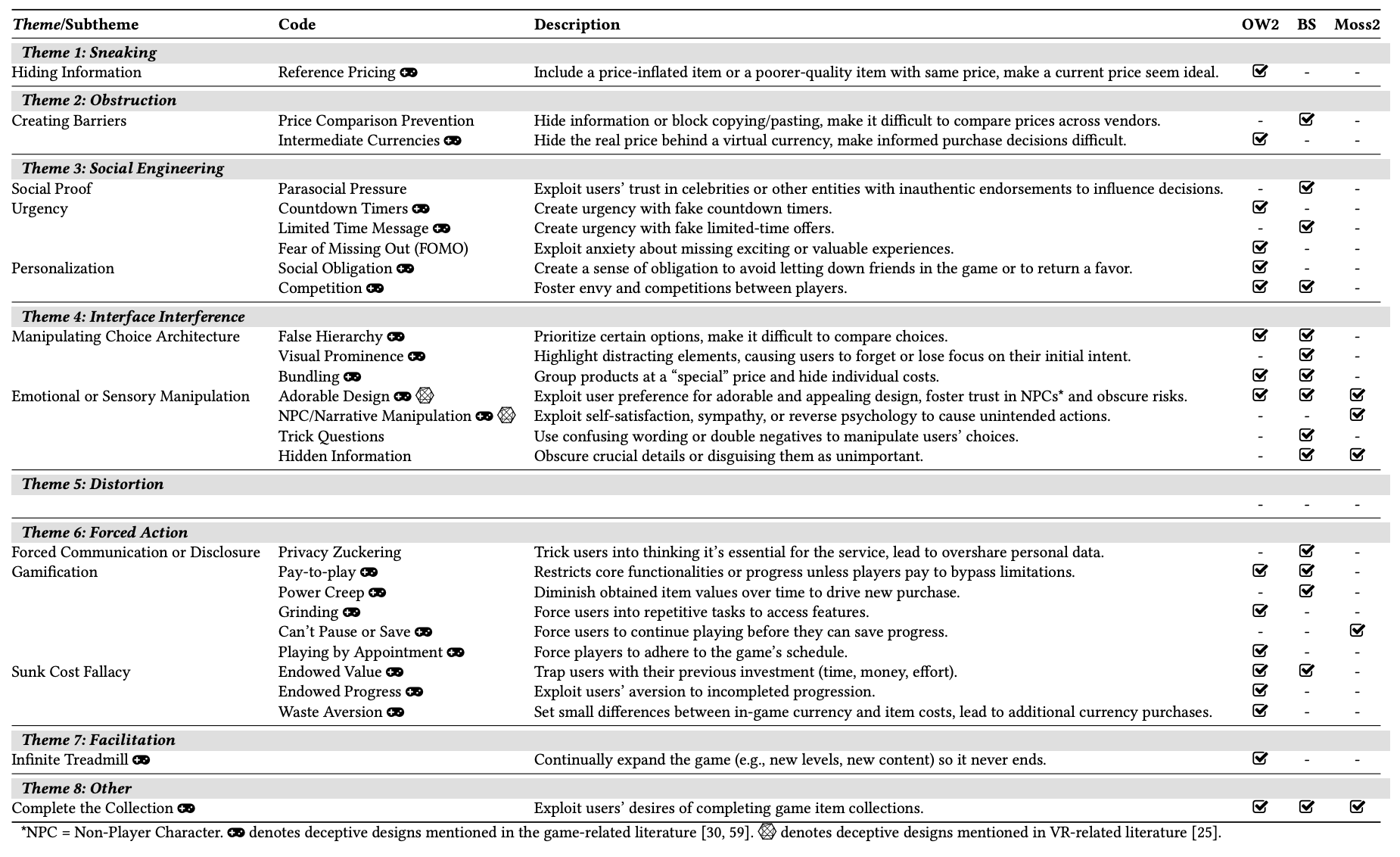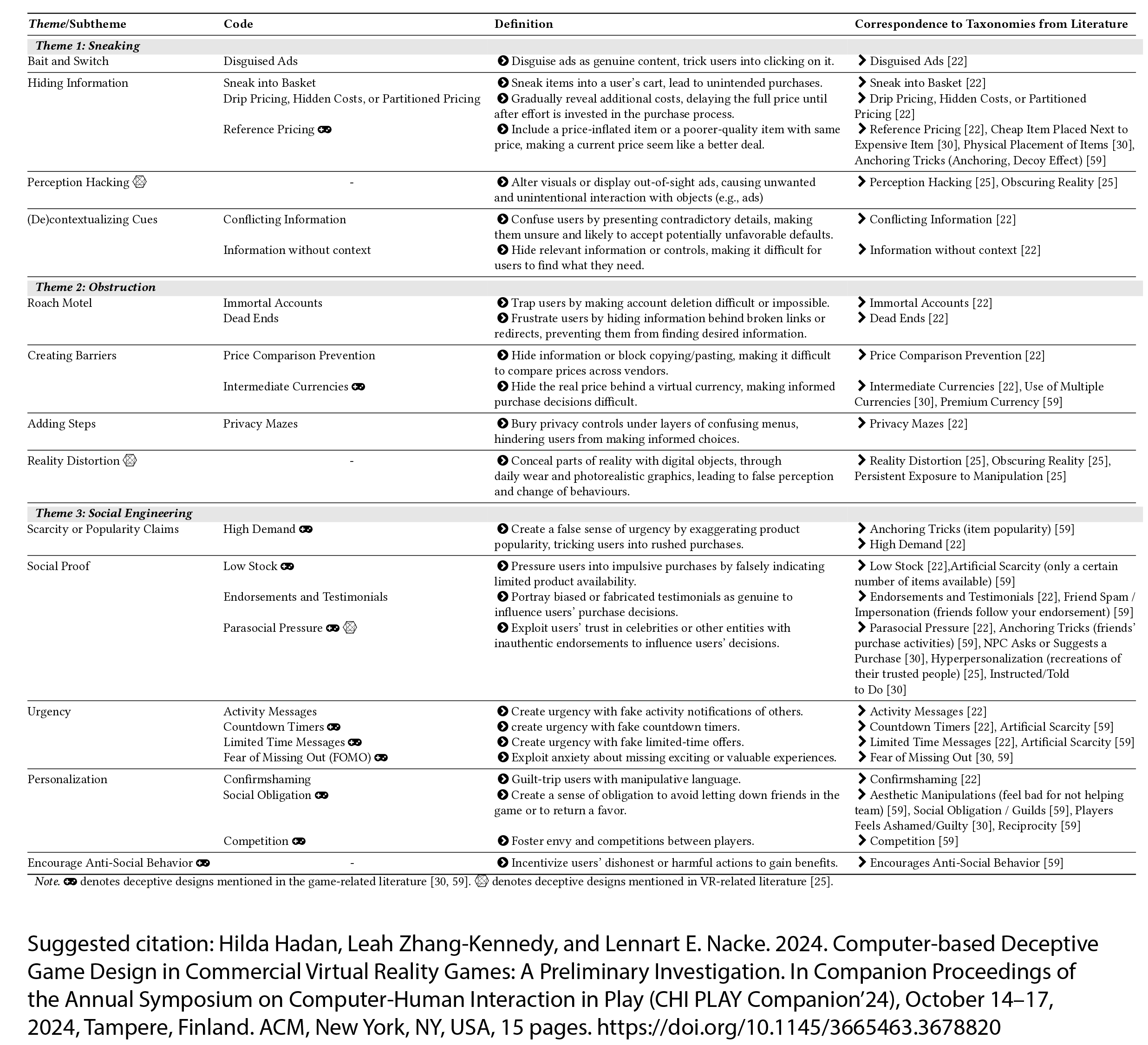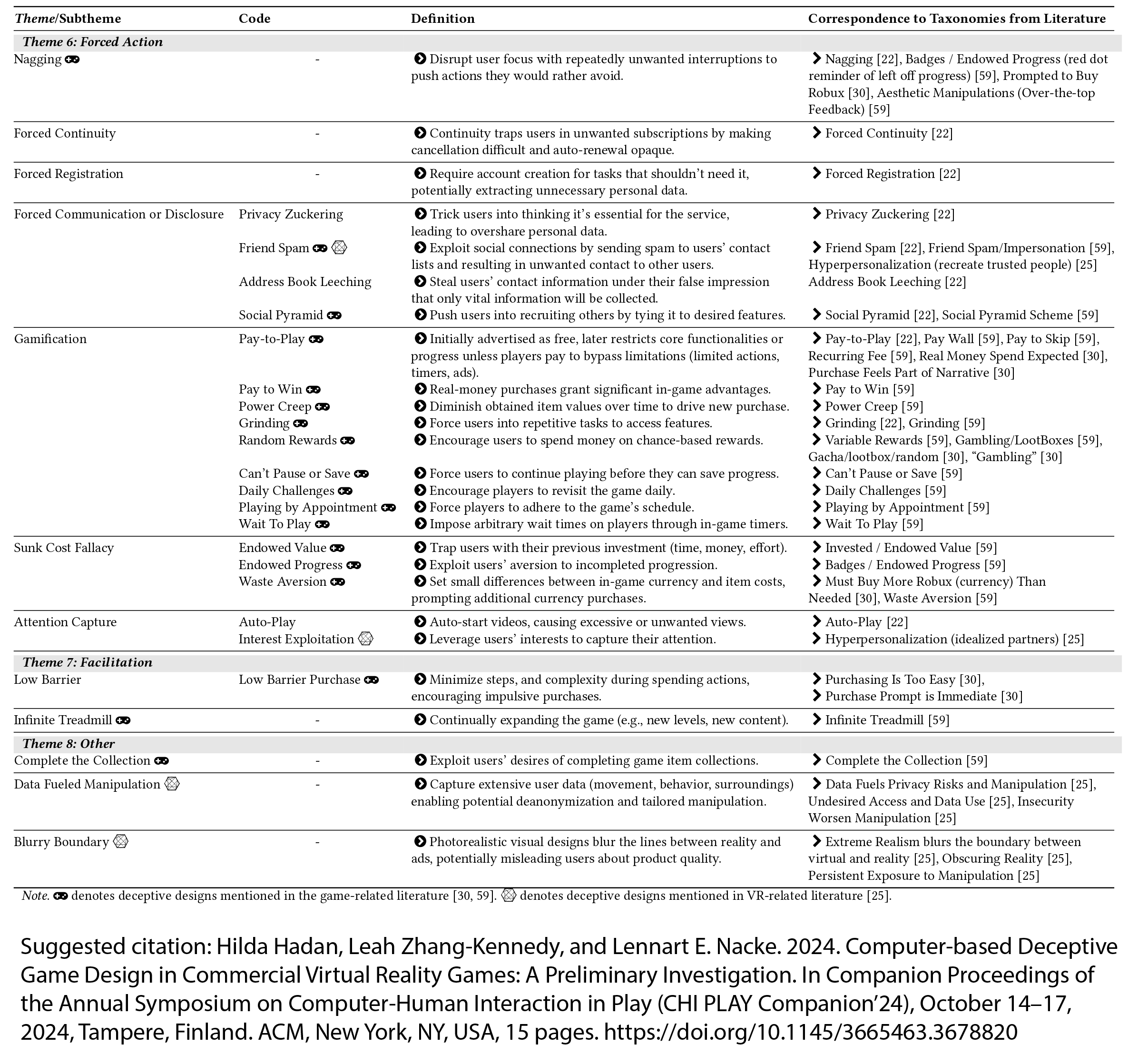Project Description

As Virtual Reality (VR) games become more popular, it is crucial to understand how deceptive game design patterns manifest and impact player experiences in this emerging medium. Our study sheds light on the presence and effects of manipulative design techniques in commercial VR games compared to a traditional computer game. We conducted an autoethnography study and developed a VR Deceptive Game Design Assessment Guide based on a critical literature review. Using our guide, we compared how deceptive patterns in a popular computer game are different from two commercial VR titles. While VR’s technological constraints, such as battery life and limited temporal manipulation, VR’s unique sensory immersion amplified the impact of emotional and sensory deception. Current VR games showed similar but evolved forms of deceptive design compared to the computer game. We forecast more sophisticated player manipulation as VR technology advances. Our findings contribute to a better understanding of how deceptive game design persists and escalates in VR. We highlight the urgent need to develop ethical design guidelines for the rapidly advancing VR games industry.
VR Deceptive Game Design Assessment Guide



We developed a VR Deceptive Game Design Assessment Guide as our deductive codebook method for comparing deceptive design in computer and VR games. We adopted Gray et al. [1]’s ontology of deceptive designs as our starting point as it is the most recent and comprehensive framework at the time of our study grounded in the foundational literature in the field (e.g., Brignull [2], Gray et al. [3], Mathur et al. [4]). However, the ontology was not tailored to deceptive design in the VR context. Therefore, we augmented our analysis with additional frameworks that focus on VR and games from Hadan et al. [5], King et al. [6], and Zagal et al. [7] due to their coverage in VR-specific [5] and game-specific [6,7] deceptive designs, and considerations for player perception in 3D interfaces [6]. To minimize complexity where appropriate, we merged variances of deceptive designs that shared similarities in their definition and characteristics. Overall, our Assessment Guide contained eight synthesized themes and 71 distinct deceptive design patterns
[1] Colin M. Gray, Cristiana Teixeira Santos, Nataliia Bielova, and Thomas Mildner. 2024. An Ontology of Dark Patterns Knowledge: Foundations, Definitions, and a Pathway for Shared Knowledge-Building. In Proceedings of the CHI Conference on Human Factors in Computing Systems (Honolulu, HI, USA) (CHI ’24). Association for Computing Machinery, New York, NY, USA, Article 289, 22 pages. https: //doi.org/10.1145/3613904.3642436
[2] Harry Brignull. 2010. Deceptive patterns - user interfaces crafted to trick you. https://www.deceptive.design/. Last accessed on July 24, 2023.
[3] Colin M Gray, Yubo Kou, Bryan Battles, Joseph Hoggatt, and Austin L Toombs. 2018. The dark (patterns) side of UX design. In Proceedings of the 2018 CHI conference on human factors in computing systems. ACM, New York, USA, 1–14.
[4] Arunesh Mathur, Mihir Kshirsagar, and Jonathan Mayer. 2021. What makes a dark pattern... dark? Design attributes, normative considerations, and measurement methods. In Proceedings of the 2021 CHI conference on human factors in computing systems. ACM, New York, USA, 1–18.
[5] Hilda Hadan, Lydia Choong, Leah Zhang-Kennedy, and Lennart E. Nacke. 2024. Deceived by Immersion: A Systematic Analysis of Deceptive Design in Extended Reality. ACM Comput. Surv. 56, 10, Article 250 (may 2024), 25 pages. https: //doi.org/10.1145/3659945
[6] John King, Dan Fitton, and Brendan Cassidy. 2023. Investigating Players’ Perceptions of Deceptive Design Practices within a 3D Gameplay Context. Proc. ACM Hum.-Comput. Interact. 7, CHI PLAY, Article 407 (oct 2023), 17 pages. https://doi.org/10.1145/3611053
[7] José P Zagal, Staffan Björk, and Chris Lewis. 2013. Dark patterns in the design of games. In Foundations of Digital Games 2013. ACM, Crete, Greece, 8 pages.
Video
Related Publications
- Hilda Hadan, Lydia Choong, Leah Zhang-Kennedy, and Lennart E. Nacke. 2024. Deceived by Immersion: A Systematic Analysis of Deceptive Design in Extended Reality. ACM Comput. Surv. 56, 10, Article 250 (May2024), 25 pages. https://doi.org/10.1145/3659945
- Hilda Hadan, Leah Zhang-Kennedy, and Lennart E. Nacke. 2024. Computer-based Deceptive Game Design in Commercial Virtual Reality Games: A Preliminary Investigation. In Companion Proceedings of the Annual Symposium on Computer-Human Interaction in Play (CHI PLAY Companion ’24), October 14–17, 2024, Tampere, Finland. ACM, New York, NY, USA, 15 pages.https://doi.org/10.1145/3665463.36788201
Related Projects





